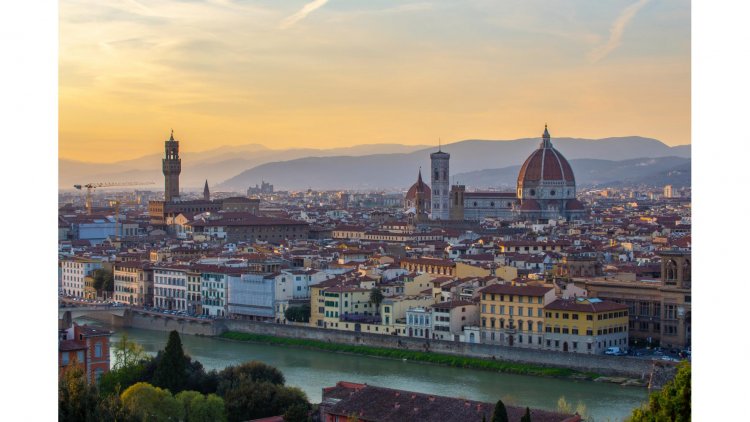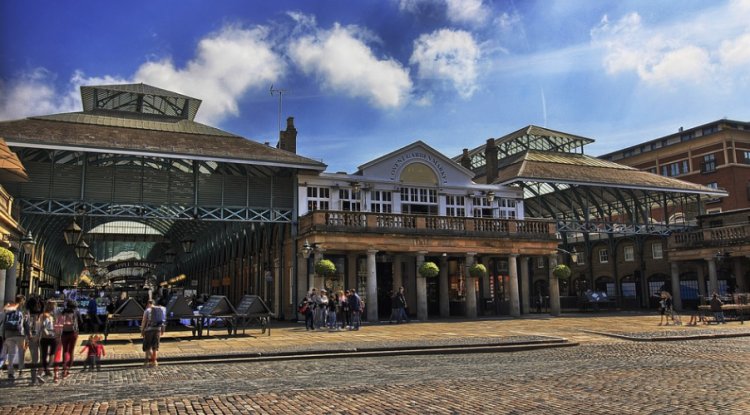Florence: The Eternal City of Art and Architecture
Florence, the cradle of the Renaissance, is a city that seems to breathe art and history from every cobblestone street. Nestled in the heart of Tuscany, it offers an unparalleled journey through centuries of artistic evolution and architectural grandeur. As you meander through Florence, you are not just exploring a city but stepping into a living museum where the past and present seamlessly intertwine.

The Baptistery of Saint John: The Gateway to a Renaissance Wonderland
Standing as one of the oldest structures in Florence, the Baptistery of Saint John (Battistero di San Giovanni) is an architectural gem that sets the stage for the city’s artistic narrative. Its octagonal shape and gleaming white and green marble facade capture the gaze of anyone approaching the cathedral complex. The Baptistery is renowned for its bronze doors, often called the "Gates of Paradise," sculpted by Lorenzo Ghiberti. These doors are a masterpiece of Renaissance art, featuring intricate scenes from the Old Testament that are both technically masterful and profoundly expressive.
The interior of the Baptistery is equally mesmerizing. The ceiling is adorned with a dazzling mosaic of Christ in Judgment, surrounded by angels and saints. This grand mosaic, dating back to the 13th century, reflects the Byzantine influence and serves as a testament to the rich religious traditions that have influenced Florence's artistic heritage.
The Duomo: Florence's Crown Jewel
Dominating the Florence skyline, the Cathedral of Santa Maria del Fiore, commonly known as the Duomo, is an architectural marvel that represents the pinnacle of Gothic and Renaissance design. Designed by Arnolfo di Cambio and later completed by Filippo Brunelleschi, the Duomo’s imposing dome is a triumph of engineering ingenuity. Brunelleschi’s dome, completed in 1436, remains the largest brick dome ever constructed, showcasing his innovative use of double-shell construction and herringbone brick patterns.
The cathedral’s facade, adorned with intricate marble patterns and sculptural details, is a feast for the eyes. It’s worth noting the elaborate statues of saints and biblical figures that embellish the exterior, which were crafted by some of the greatest artists of the time, including Donatello and Luca della Robbia.
Inside, the cathedral's vast space is illuminated by stunning stained glass windows and features a fresco of the Last Judgment by Giorgio Vasari and Federico Zuccari. The interior’s expansive nave and impressive artworks create a sense of awe and reverence, making it a central piece of Florence's cultural identity.
The Uffizi Gallery: A Renaissance Treasure Trove
No journey through Florence’s art scene would be complete without a visit to the Uffizi Gallery (Galleria degli Uffizi). Established by Francesco I de' Medici in 1584, the Uffizi is one of the most renowned art museums in the world, housing an unparalleled collection of Renaissance masterpieces.
Walking through the Uffizi is like stepping into an art history book. You’ll encounter iconic works such as Sandro Botticelli’s "The Birth of Venus" and "Primavera," Leonardo da Vinci’s "Annunciation," and Michelangelo’s "Doni Tondo." Each gallery is meticulously curated to showcase the evolution of artistic styles and the brilliance of Renaissance artists.
The museum’s architecture itself is worth noting. Designed by Giorgio Vasari, the Uffizi features a stunning corridor with a long, narrow design that allows for a continuous flow of light, enhancing the viewing experience. The museum's original function as administrative offices is still evident in the building's layout, which adds a layer of historical context to the artistic experience.
The Ponte Vecchio: Florence’s Iconic Bridge
The Ponte Vecchio, or "Old Bridge," is more than just a crossing over the Arno River; it’s a symbol of Florence’s enduring charm. Built in 1345, the bridge is renowned for the shops that line its walkways. Originally, these shops were occupied by butchers, but today they are filled with goldsmiths and jewelers, continuing a tradition that dates back centuries.
The Ponte Vecchio's architecture is unique due to its medieval design and the fact that it was the only bridge in Florence to survive World War II intact. The bridge’s picturesque views and its bustling atmosphere make it a popular spot for both tourists and locals.
Walking across the Ponte Vecchio offers a glimpse into the historical commercial life of Florence and provides stunning views of the city’s skyline. The bridge also features the Vasari Corridor, an elevated passageway built by Giorgio Vasari for the Medici family to move safely between their residence and the Uffizi Gallery. This corridor offers a unique perspective of the city and its landmarks.
The Palazzo Vecchio: Florence's Medieval Fortress
The Palazzo Vecchio stands proudly in Piazza della Signoria, serving as Florence's town hall and a symbol of the city's political history. Originally built in the 13th century, the palace’s imposing facade and defensive towers reflect its medieval origins. The Palazzo Vecchio has been a center of political power in Florence for centuries, housing the city’s governing body and hosting important ceremonies.
The interior of the Palazzo Vecchio is equally impressive, with lavishly decorated rooms and frescoes that illustrate the grandeur of Renaissance Florence. The Salone dei Cinquecento, or Hall of the Five Hundred, is particularly noteworthy. This grand hall, designed by Giorgio Vasari, was used for important council meetings and boasts an elaborate ceiling fresco and grandiose decor.
The palace also features the Museum of the Palazzo Vecchio, which provides insight into the history of Florence through a collection of artifacts, art, and interactive exhibits. The museum's various rooms and galleries offer a fascinating exploration of the city’s political and cultural evolution.
Santa Croce Basilica: The Pantheon of Florence’s Great Minds
Santa Croce Basilica, located in the Piazza Santa Croce, is another significant religious and cultural landmark in Florence. Known as the Pantheon of Florence’s great minds, the basilica is the final resting place of some of Italy’s most illustrious figures, including Michelangelo, Galileo Galilei, and Niccolò Machiavelli.
The basilica’s Gothic architecture, characterized by its simple yet elegant facade and soaring interior, contrasts with the ornate decorations found in other Florentine churches. Inside, the Chapel of the Holy Cross houses a series of striking frescoes by Giotto, depicting scenes from the life of Christ.
Santa Croce’s art and architecture reflect the convergence of religious devotion and intellectual achievement that has shaped Florence's legacy. The basilica’s historical and cultural significance is a testament to the city’s role as a center of art and learning during the Renaissance.
The Accademia Gallery: Michelangelo's Masterpieces
The Accademia Gallery (Galleria dell'Accademia) is synonymous with one of the most celebrated sculptures in art history: Michelangelo's "David." Created between 1501 and 1504, this marble statue epitomizes Renaissance ideals of beauty and human form. Standing at an imposing 17 feet tall, "David" represents the biblical hero who defeated Goliath, symbolizing the strength and potential of the human spirit.
The Accademia Gallery's collection extends beyond Michelangelo. It includes works from the 13th to the 16th centuries, with significant pieces by artists such as Sandro Botticelli and Domenico Ghirlandaio. The museum’s layout, originally intended as a workshop for art students, provides a unique setting for viewing Renaissance art, reflecting the educational mission that underpins its establishment.
The Bargello Museum: Sculpture’s Sacred Space
The Bargello Museum (Museo Nazionale del Bargello) is a treasure trove of Renaissance sculpture and decorative arts. Housed in a former medieval fortress, the museum's collection includes masterpieces by Donatello, including his celebrated "David" and "St. George," as well as works by Michelangelo, including the "Bacchus" and "Pieta."
The Bargello’s architecture complements its collection. The building's austere, fortress-like exterior contrasts with the rich artistic treasures within. The museum's courtyard, with its Renaissance sculptures and intricate stonework, offers a serene environment that highlights the artistry of Florence’s sculptural heritage.
The Medici Chapels: A Dynasty's Final Resting Place
The Medici Chapels (Cappelle Medicee), part of the Basilica of San Lorenzo, are a stunning example of Renaissance funerary art and architecture. Commissioned by the powerful Medici family, the chapels are divided into the New Sacristy and the Old Sacristy. The New Sacristy, designed by Michelangelo, is renowned for its exquisite marble tombs of the Medici dukes, including Lorenzo the Magnificent and Giuliano de' Medici. Michelangelo’s sculptures, including "Night" and "Day," and "Dawn" and "Dusk," are masterful representations of the Medici’s opulence and artistic patronage.
The Old Sacristy, designed by Filippo Brunelleschi, is an earlier example of Renaissance architecture. Its harmonious proportions and elegant design set a precedent for future architectural developments and reflect the Medici family's significant influence on Florence's artistic landscape.
The Boboli Gardens: A Renaissance Eden
The Boboli Gardens (Giardini di Boboli) offer a serene retreat from the bustling city streets and provide a glimpse into the grandeur of Renaissance landscaping. Designed in the 16th century, these gardens were commissioned by the Medici family and are a prime example of Italian formal gardens.
The gardens feature a collection of statues, fountains, and grottos, arranged in a meticulously planned layout that emphasizes perspective and spatial harmony. Highlights include the Fountain of Neptune, the Grotta del Buontalenti, and the Viottolone, a grand avenue lined with cypress trees that provides stunning views of Florence and the surrounding Tuscan countryside.
The Boboli Gardens are not only a testament to Renaissance horticultural design but also serve as an open-air museum, showcasing the intersection of art, nature, and architecture.
The Church of San Miniato al Monte: A Hidden Gem
Perched on a hill overlooking Florence, the Church of San Miniato al Monte is a hidden gem that offers a different perspective on the city’s religious and artistic heritage. Founded in the 11th century, the church is an excellent example of Romanesque architecture, with its distinctive green and white marble facade and richly decorated interior.
The church’s mosaic-covered apse and intricate marble flooring are particularly noteworthy. The adjacent monastery also houses a beautiful cloister and an impressive array of medieval frescoes. San Miniato al Monte’s elevated position provides panoramic views of Florence, making it a peaceful and contemplative spot away from the city’s more crowded attractions.
The Ospedale degli Innocenti: Architecture and Social Reform
The Ospedale degli Innocenti (Hospital of the Innocents) is a landmark in both architecture and social history. Designed by Filippo Brunelleschi in the early 15th century, this building is one of the earliest examples of Renaissance architecture and is renowned for its elegant proportions and harmonious design.
The Ospedale degli Innocenti was established to care for orphaned and abandoned children, reflecting the Medici family's commitment to social reform and philanthropy. The building’s loggia and serene courtyard are testaments to Brunelleschi’s innovative use of space and perspective, marking a significant departure from medieval architectural conventions.
The Church of Santa Maria Novella: Gothic Grandeur
The Church of Santa Maria Novella, located in the Piazza Santa Maria Novella, is a splendid example of Gothic architecture infused with Renaissance elements. Designed by the Dominican friars, the church features a striking façade with intricate geometric patterns and a spacious interior adorned with frescoes by Masaccio and Ghirlandaio.
Santa Maria Novella’s artistic treasures include the frescoes in the Trinità Chapel by Masaccio, which are considered pivotal works in the development of linear perspective. The church’s blend of Gothic and Renaissance styles reflects Florence’s evolving artistic sensibilities and its role as a center of innovation.
The Palazzo Pitti: The Medici's Grand Residence
The Palazzo Pitti, a grand Renaissance palace, was acquired by the Medici family in the 16th century and became their principal residence. The palace is renowned for its vast and opulent rooms, including the Palatine Gallery, which houses an extensive collection of Renaissance paintings by artists such as Raphael, Titian, and Rubens.
The Palazzo Pitti’s opulent design and extensive art collections reflect the Medici family’s wealth and artistic patronage. The palace’s transformation from a noble residence to a museum highlights the ongoing appreciation of Florence’s cultural and artistic heritage.
Overall Conclusive Paragraph
Florence is a city where the echoes of the past resonate through its art and architecture, creating a tapestry that is both rich and complex. From the grandiose Duomo and the masterful works of Michelangelo to the serene Boboli Gardens and the historical Medici Chapels, every corner of Florence offers a unique glimpse into its illustrious history. As you traverse the city’s streets, you are walking through a living gallery of Renaissance brilliance and architectural innovation. Florence’s ability to preserve and celebrate its artistic heritage makes it a timeless destination for art lovers and history enthusiasts alike.
Disclaimer: The information provided in this article is for educational purposes only and should not be considered medical advice. If you have any health concerns or are experiencing symptoms, it is important to consult with a healthcare professional, such as a doctor or clinic, for proper diagnosis and treatment. Always seek the advice of your doctor or other qualified health provider with any questions you may have regarding a medical condition. Do not disregard professional medical advice or delay in seeking it because of something you have read in this article.
What's Your Reaction?





















